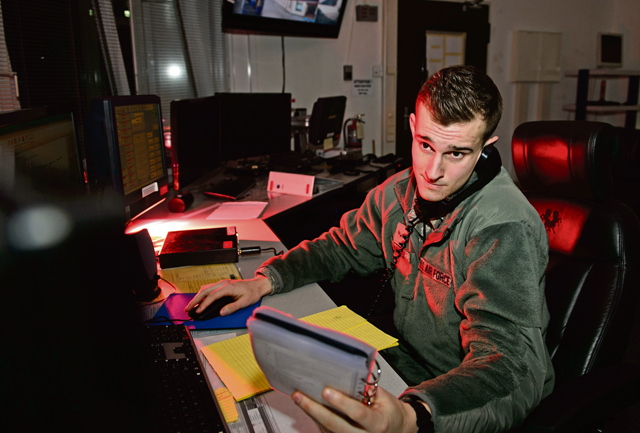
It’s 2 a.m., and they sit surrounded by a quiet calm only broken by occasional banter from a security TV. The smell of coffee permeates the air as the Airmen file their daily work.
Suddenly, a flurry of flickering screens and ringing phones break the calm. One of them answers the line and hears, “We have an emergency.”
These Airmen are the Ramstein Air Base Command Post controllers. Since the beginning of their technical training, they have been groomed to keep their composure. The command post is the nucleus for Ramstein and the KMC, serving the largest concentration of Americans outside the continental U.S.
“The mission is so fast paced here that you don’t have time to sit back and relax,” said Airman 1st Class Kodi Tomassi, 86th Airlift Wing Command Post junior emergency actions controller. “We have to be on the edge of our seat the entire time, because we never know when that first phone call is going to come in relaying, ‘We have this emergency going on.’”
Controllers are plugged into a control center linked by telephone networks, radio communications, computers and alerting systems. The Airmen use this center to advise commanders, direct and monitor aircraft locations, as well as react to natural and manmade emergencies.
“I like to think of the command post and the controllers as unsung heroes of emergency response and, ultimately, to the mission every day,” Tomassi said. “Everybody is going to see the cops, (the medics, the firefighters and so forth). Nobody sees us.”
The command post facilitates the information needed by emergency responders in order for them to save lives.
Tomassi is one of a small number of Airmen sealed behind security and blast doors handling emergencies for more than 57,000 Department of Defense personnel. At any time during the day or night, the phones can ring with sensitive emergency action messages. However, not all calls are emergencies. Some are remembered for a lifetime.
For Master Sgt. Shauna Lolley, 86th AW Command Post superintendent, one memorable event involved coordinating the location of a reindeer-powered cargo aircraft delivering very special packages.
“I volunteered over Christmas Eve to do the Santa Tracker,” Lolley said. “That was fantastic. I would get phone calls from all over the world. Kids would ask where Santa was. It was some of the busier nights and shifts I had ever worked … I love my job. I can’t imagine doing anything else. I try to bring that excitement to all my Airmen.”
They may not see the sun rise, but the flurry of action inside their building begins to calm as the last calls come in, concluding the emergency. Tomassi and the other controllers’ shifts may be over but, as they walk out of the building, they tag in the next crew.
No matter the emergency, whether it is manmade or from Mother Nature, the command post is online waiting for a phone call or warning bell.


